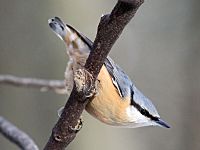Three Groves Wood facts for kids
Three Groves Wood is a special nature reserve in Gloucestershire, England. It covers about 3.3 hectares (which is like 8 football fields!). This wood is so important that it's listed as a Key Wildlife Site (KWS) in the local plan for the Stroud area. This means it's a really important place for plants and animals.
The Gloucestershire Wildlife Trust owns and looks after Three Groves Wood. It was given to them in 1986 by someone who wanted to help protect nature.
Contents
Welcome to Three Groves Wood!
Three Groves Wood is part of a much bigger, very old forest. This forest is found on the north side of the Frome Valley. The town of Chalford is about one mile to the west.
The wood sits on a type of rock called limestone, which is often found in this area. You can even see signs of small quarries (places where rock was dug out) inside the wood. There's a public path that goes right through the wood, so you can explore it! At the bottom of the hill, there's also a small stream.
The wood is made up of three separate areas, which used to be called Pearce Grove, Gassons Grove, and Teals Grove. It's a shady place, and many different kinds of plants grow on the ground.
What Kinds of Trees Grow Here?
Most of the trees in Three Groves Wood are beech trees. These kinds of woodlands were often managed to grow wood for building or other uses. You can also find some ash and pedunculate oak trees mixed in with the beech.
There are also older trees that have been cut in a special way called coppicing. This means the trees were cut close to the ground, and new shoots grew back from the stump. This helps the trees regrow and provides wood. You can see coppiced beech and whitebeam trees here.
The smaller trees and bushes in the wood include hazel, spindle, yew, crab apple, field maple, holly, guelder-rose, and the wayfaring-tree.
Amazing Plants on the Ground
In the spring, the forest floor comes alive with beautiful flowers. You might spot woodruff, primrose, bluebell, wood anemone, yellow archangel, and the common dog-violet.
As summer arrives, other flowers appear, like broad-leaved helleborine, stinking hellebore, and nettle-leaved bellflower.
You'll also find different types of grasses, such as wood barley and wood millet. In the old quarry areas, you can see ferns like hart's-tongue and soft shield-fern.
Near the edge of the wood, where it meets the fields, you might see Quaking-grass and glaucous sedge. The stream area is home to water plants like blue water-speedwell, brooklime, and alternate-leaved golden-saxifrage.
Tiny Creatures and Birds
This wood is a great place for many different animals!
Invertebrates
You can find many invertebrates here. These are animals without backbones, like insects and snails. Butterflies like the gatekeeper and silver-washed fritillary flutter through the trees. You might also spot special snails, called molluscs, like Ena montana and Zenobiella subrufescens.
Bird Life
Many birds also call Three Groves Wood home. Keep an eye out for the nuthatch, the bright green green woodpecker, and the spotted flycatcher.
Looking After the Wood
Looking after the woodland is very important to make sure there's enough sunlight for all the different plants on the ground to grow. This is called woodland management.
One way they do this is by thinning some of the beech trees. This means carefully removing a few trees so that the remaining trees have more space and light. They also use coppicing for hazel trees and create open, sunny spots called glades. All these actions help the wood stay healthy and full of life.
Exploring the Area
There's a special guide that tells you about walks in the Golden Valley area. This guide includes information about Three Groves Wood and four other nearby nature reserves. These are Strawberry Banks SSSI, Siccaridge Wood, Daneway Banks SSSI, and Sapperton Valley.
The walks also take you through other old woodlands, past Oakridge village, and along parts of the old Thames and Severn Canal. It's a great way to see lots of nature and history!


